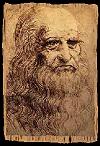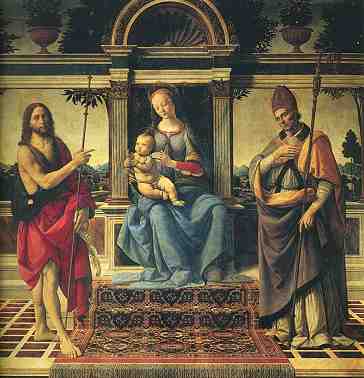|
The commission for this painting was given to Verrocchio in late 1474. He was to produce an altarpiece for the oratory of the Virgine di Piazza in the cathedral of Pistoia. The execution of the painting was to be divided into two stages with the first being from 1475-1479. After this time little remained to be done to complete the work, however no further painting was carried out until six years later in 1485. This was due to non-payment of fees due to the artists.
The painting was first associated with Leonardo in a seventeenth-century history of Pistoia and since this time efforts have often been made to determine the extent of his involvement, if indeed there was any. Some people consider Leonardo may have been responsible for the entire painting whilst others attribute various details to him with some evidence being put forth in the form of a sheet of drawings at the Uffizi Gallery which carry two cryptic inscriptions. One of these specifically names the city of Pistoia while the other says, "bre 1478 inchominciai le 2 Vergine Marie", which is thought to be a direct reference to this painting. The collection housed at Windsor Castle also contains a drawing of St. John which, though it differs in many respects from the painting, could conceivably be a preliminary sketch for the work.
We can be certain Leonardo was at Verrocchio's during the time the painting was executed, but few critics are satisfied with the attribution of this work to him, pointing out that Leonardesque elements were often borrowed and that certain areas of this work suggest the less talented hand of Lorenzo di Credi. It is believed that two predellas were also painted for this altarpiece and it has been noted that the standard of work between the predellas and the Madonna di Piazza varies considerably, suggesting different artists carried out the pieces. This does not in any way support the theory that Leonardo was involved and it is more likely that Verrocchio turned this work over to another pupil, Lorenzo di Credi, who carried out most of the work on the main painting and had assistants to do the predellas.
|
|


